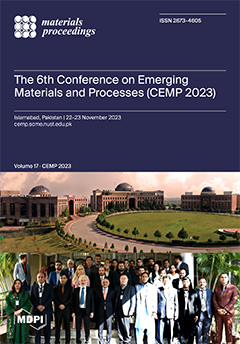Mater. Proc., 2024, CEMP 2023
The 6th Conference on Emerging Materials and Processes (CEMP 2023)
Islamabad, Pakistan | 22–23 November 2023
Volume Editors:
Sofia Javed, National University of Sciences and Technology, Pakistan
Waheed Miran, National University of Sciences and Technology, Pakistan
Erum Pervaiz, National University of Sciences and Technology, Pakistan
Iftikhar Ahmad, National University of Sciences and Technology, Pakistan
- Issues are regarded as officially published after their release is announced to the table of contents alert mailing list.
- You may sign up for e-mail alerts to receive table of contents of newly released issues.
- PDF is the official format for papers published in both, html and pdf forms. To view the papers in pdf format, click on the "PDF Full-text" link, and use the free Adobe Reader to open them.



